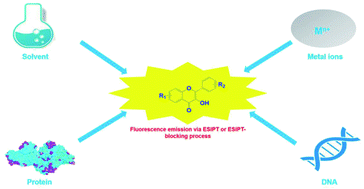3-Hydroxyflavone derivatives: promising scaffolds for fluorescent imaging in cells
Abstract
As a typical class of excited-state intramolecular proton transfer (ESIPT) molecules, 3-hydroxyflavone derivatives (3HF, also known as flavonols) have received much attention recently. Thereinto, the role of hydrophobic microenvironment is significant importance in promoting the process and effects of ESIPT, which can be regulated by the solvents, the existence of metal ions and proteins rich with α-helix structures or the advanced DNA structures. Considering that plenty of biological macromolecules offer cellular hydrophobic microenvironment, enhancing the ESIPT effects and resulting in dual emission, 3HF could be a promising scaffold for the development of fluorescent imaging in cells. Furthermore, as the widespread occurance of compounds with biological activity in plants, 3HF derivatives are much more secure to be cellular diagnosis and treatment integrated fluorescent probes. In this review, multiple regulatory strategies for the fluorescence emission of 3HF derivatives have been collectively and comprehensively analyzed, including the solvent effects, metal chelation, interaction with proteins or DNAs, which would be beneficial for ESIPT-promoting or ESIPT-blocking processes and then enhance or control the fluorescence emission of 3HF effectively. We expect that this review would provide a new perspective to develop novel 3HF-based fluorescent sensors for imaging in cells and plants.

- This article is part of the themed collection: 2021 Reviews in RSC Advances


 Please wait while we load your content...
Please wait while we load your content...